Predictive Analytics in Healthcare
VerifiedAdded on 2020/03/16
|11
|2356
|329
AI Summary
This report delves into the functional and non-functional requirements for developing a 'My Health Record' system leveraging cloud technology. It examines how predictive analytics can enhance patient satisfaction and data security within the healthcare industry, citing examples like Amazon and Netflix. The document discusses advantages of cloud computing in healthcare, potential challenges, and provides recommendations for Headspace to implement predictive analytics effectively.
Contribute Materials
Your contribution can guide someone’s learning journey. Share your
documents today.

Cloud Based Health Record Requirements for HeadSpace Organization
Cloud Computing is the current generation’s platform that has been widely implemented in
Healthcare industry. In this report, the functional and non-functional requirements of an electronic
record termed as “My Health Record” designed for recording the health summary of 12 to 25 aged
patients are discussed. Moreover, the pros and cons of deploying cloud solution in Headspace are
illustrated and the recommendations of appropriate Software Development Life Cycle (SDLC) are also
offered in this report.
Cloud Computing is the current generation’s platform that has been widely implemented in
Healthcare industry. In this report, the functional and non-functional requirements of an electronic
record termed as “My Health Record” designed for recording the health summary of 12 to 25 aged
patients are discussed. Moreover, the pros and cons of deploying cloud solution in Headspace are
illustrated and the recommendations of appropriate Software Development Life Cycle (SDLC) are also
offered in this report.
Secure Best Marks with AI Grader
Need help grading? Try our AI Grader for instant feedback on your assignments.

Table of Contents.
1. Introduction 3
2. Functional and Non-Functional Requirements 3
2.1. Functional Requirements 3
2.1.1. “My Health Record” Design Considerations 3
2.1.2. System Architecture 4
2.1.3. Cloud-Based System Requirements 4
2.1.3.1. Middleware 4
2.1.3.2. Database Server 4
2.1.3.3. Authorization Server 5
2.2. Non Functional Requirements 5
2.2.1. Reliability 5
2.2.2. Performance 5
2.2.3. Security 5
2.2.4. Usability 6
3. Strengths and Weakness of Cloud Based Solution 6
4. Pros and Cons of Predictive and Adaptive SDLC 8
5. Recommendations 9
6. Conclusion 10
7. Reference 10
2
1. Introduction 3
2. Functional and Non-Functional Requirements 3
2.1. Functional Requirements 3
2.1.1. “My Health Record” Design Considerations 3
2.1.2. System Architecture 4
2.1.3. Cloud-Based System Requirements 4
2.1.3.1. Middleware 4
2.1.3.2. Database Server 4
2.1.3.3. Authorization Server 5
2.2. Non Functional Requirements 5
2.2.1. Reliability 5
2.2.2. Performance 5
2.2.3. Security 5
2.2.4. Usability 6
3. Strengths and Weakness of Cloud Based Solution 6
4. Pros and Cons of Predictive and Adaptive SDLC 8
5. Recommendations 9
6. Conclusion 10
7. Reference 10
2
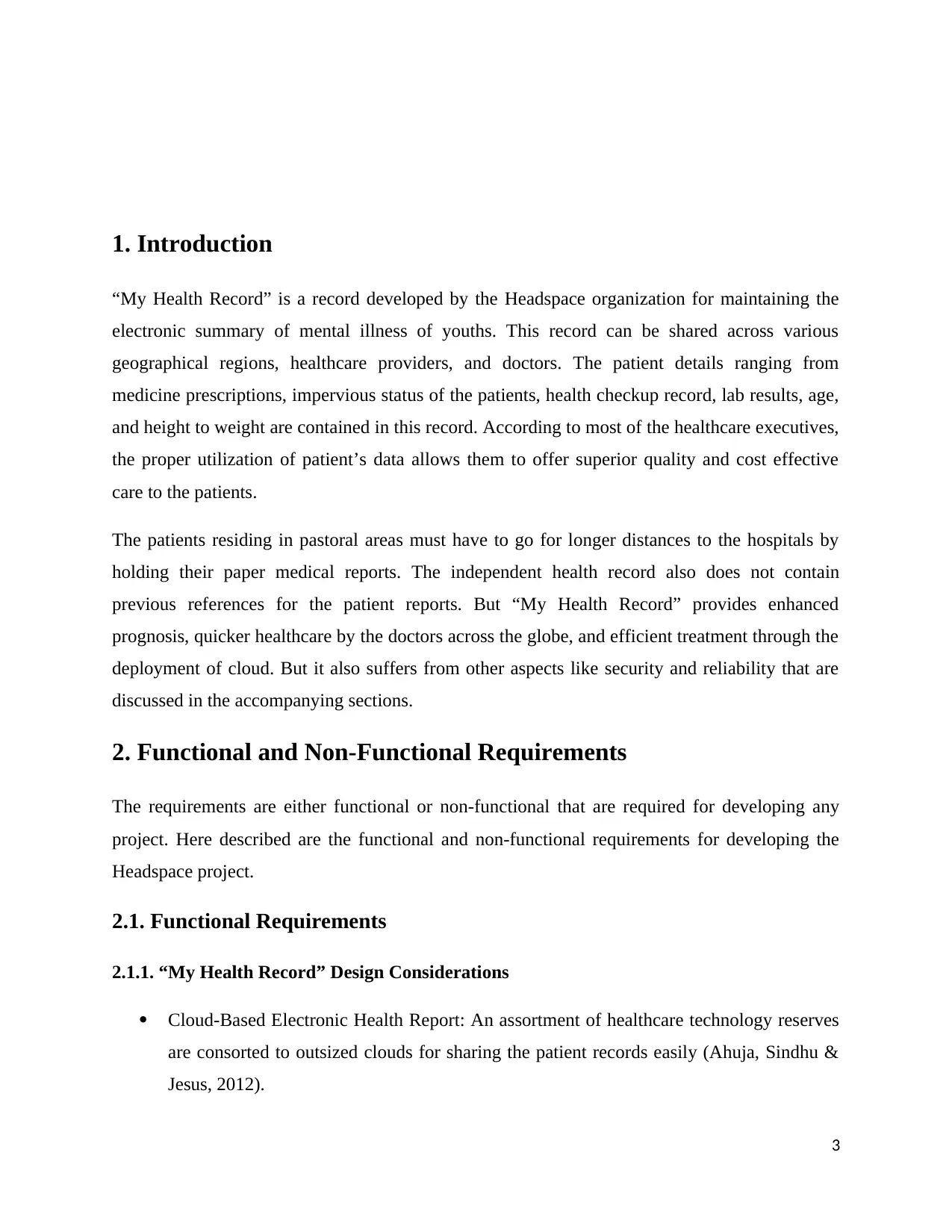
1. Introduction
“My Health Record” is a record developed by the Headspace organization for maintaining the
electronic summary of mental illness of youths. This record can be shared across various
geographical regions, healthcare providers, and doctors. The patient details ranging from
medicine prescriptions, impervious status of the patients, health checkup record, lab results, age,
and height to weight are contained in this record. According to most of the healthcare executives,
the proper utilization of patient’s data allows them to offer superior quality and cost effective
care to the patients.
The patients residing in pastoral areas must have to go for longer distances to the hospitals by
holding their paper medical reports. The independent health record also does not contain
previous references for the patient reports. But “My Health Record” provides enhanced
prognosis, quicker healthcare by the doctors across the globe, and efficient treatment through the
deployment of cloud. But it also suffers from other aspects like security and reliability that are
discussed in the accompanying sections.
2. Functional and Non-Functional Requirements
The requirements are either functional or non-functional that are required for developing any
project. Here described are the functional and non-functional requirements for developing the
Headspace project.
2.1. Functional Requirements
2.1.1. “My Health Record” Design Considerations
Cloud-Based Electronic Health Report: An assortment of healthcare technology reserves
are consorted to outsized clouds for sharing the patient records easily (Ahuja, Sindhu &
Jesus, 2012).
3
“My Health Record” is a record developed by the Headspace organization for maintaining the
electronic summary of mental illness of youths. This record can be shared across various
geographical regions, healthcare providers, and doctors. The patient details ranging from
medicine prescriptions, impervious status of the patients, health checkup record, lab results, age,
and height to weight are contained in this record. According to most of the healthcare executives,
the proper utilization of patient’s data allows them to offer superior quality and cost effective
care to the patients.
The patients residing in pastoral areas must have to go for longer distances to the hospitals by
holding their paper medical reports. The independent health record also does not contain
previous references for the patient reports. But “My Health Record” provides enhanced
prognosis, quicker healthcare by the doctors across the globe, and efficient treatment through the
deployment of cloud. But it also suffers from other aspects like security and reliability that are
discussed in the accompanying sections.
2. Functional and Non-Functional Requirements
The requirements are either functional or non-functional that are required for developing any
project. Here described are the functional and non-functional requirements for developing the
Headspace project.
2.1. Functional Requirements
2.1.1. “My Health Record” Design Considerations
Cloud-Based Electronic Health Report: An assortment of healthcare technology reserves
are consorted to outsized clouds for sharing the patient records easily (Ahuja, Sindhu &
Jesus, 2012).
3
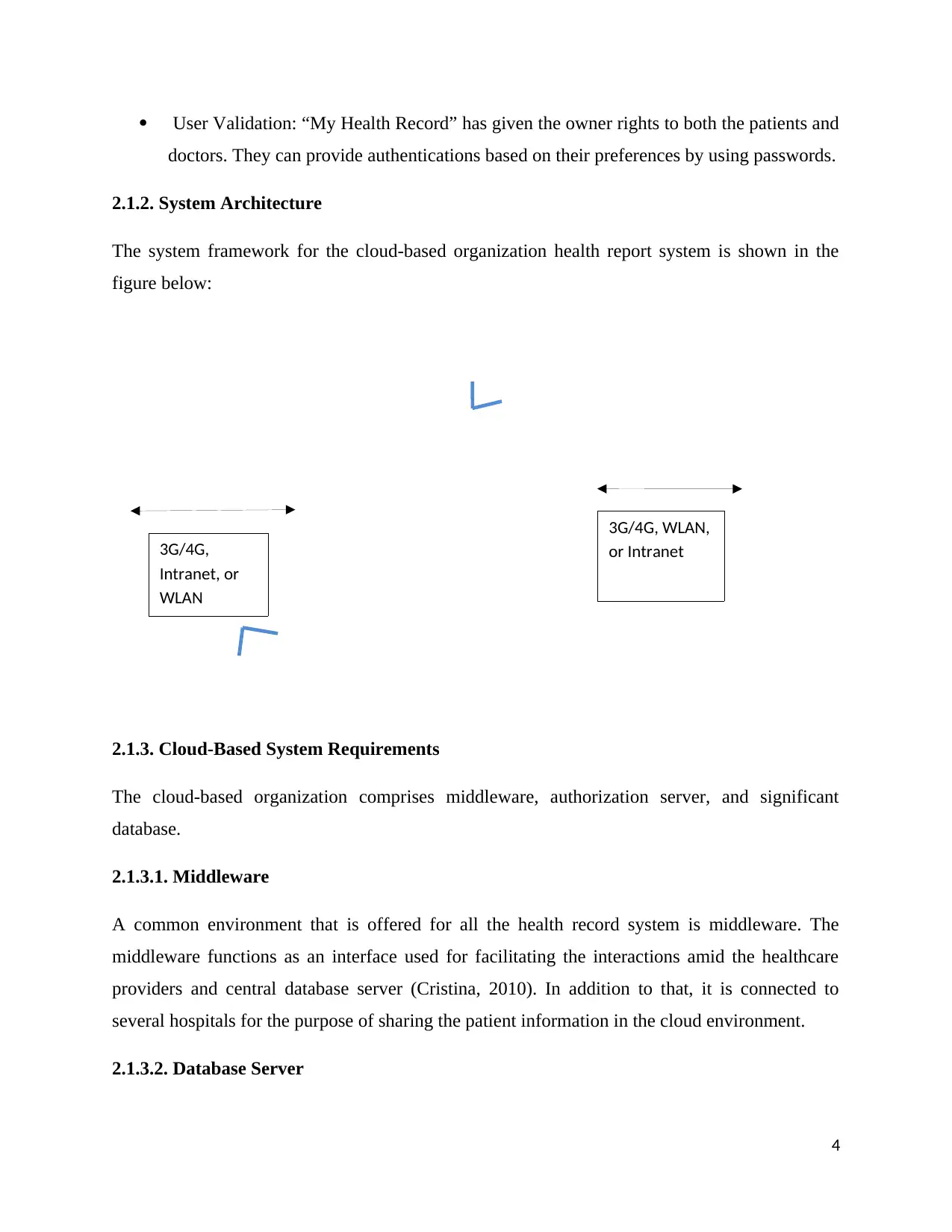
User Validation: “My Health Record” has given the owner rights to both the patients and
doctors. They can provide authentications based on their preferences by using passwords.
2.1.2. System Architecture
The system framework for the cloud-based organization health report system is shown in the
figure below:
2.1.3. Cloud-Based System Requirements
The cloud-based organization comprises middleware, authorization server, and significant
database.
2.1.3.1. Middleware
A common environment that is offered for all the health record system is middleware. The
middleware functions as an interface used for facilitating the interactions amid the healthcare
providers and central database server (Cristina, 2010). In addition to that, it is connected to
several hospitals for the purpose of sharing the patient information in the cloud environment.
2.1.3.2. Database Server
4
HospitalX3G/4G,
Intranet, or
WLAN
3G/4G, WLAN,
or Intranet
doctors. They can provide authentications based on their preferences by using passwords.
2.1.2. System Architecture
The system framework for the cloud-based organization health report system is shown in the
figure below:
2.1.3. Cloud-Based System Requirements
The cloud-based organization comprises middleware, authorization server, and significant
database.
2.1.3.1. Middleware
A common environment that is offered for all the health record system is middleware. The
middleware functions as an interface used for facilitating the interactions amid the healthcare
providers and central database server (Cristina, 2010). In addition to that, it is connected to
several hospitals for the purpose of sharing the patient information in the cloud environment.
2.1.3.2. Database Server
4
HospitalX3G/4G,
Intranet, or
WLAN
3G/4G, WLAN,
or Intranet
Secure Best Marks with AI Grader
Need help grading? Try our AI Grader for instant feedback on your assignments.
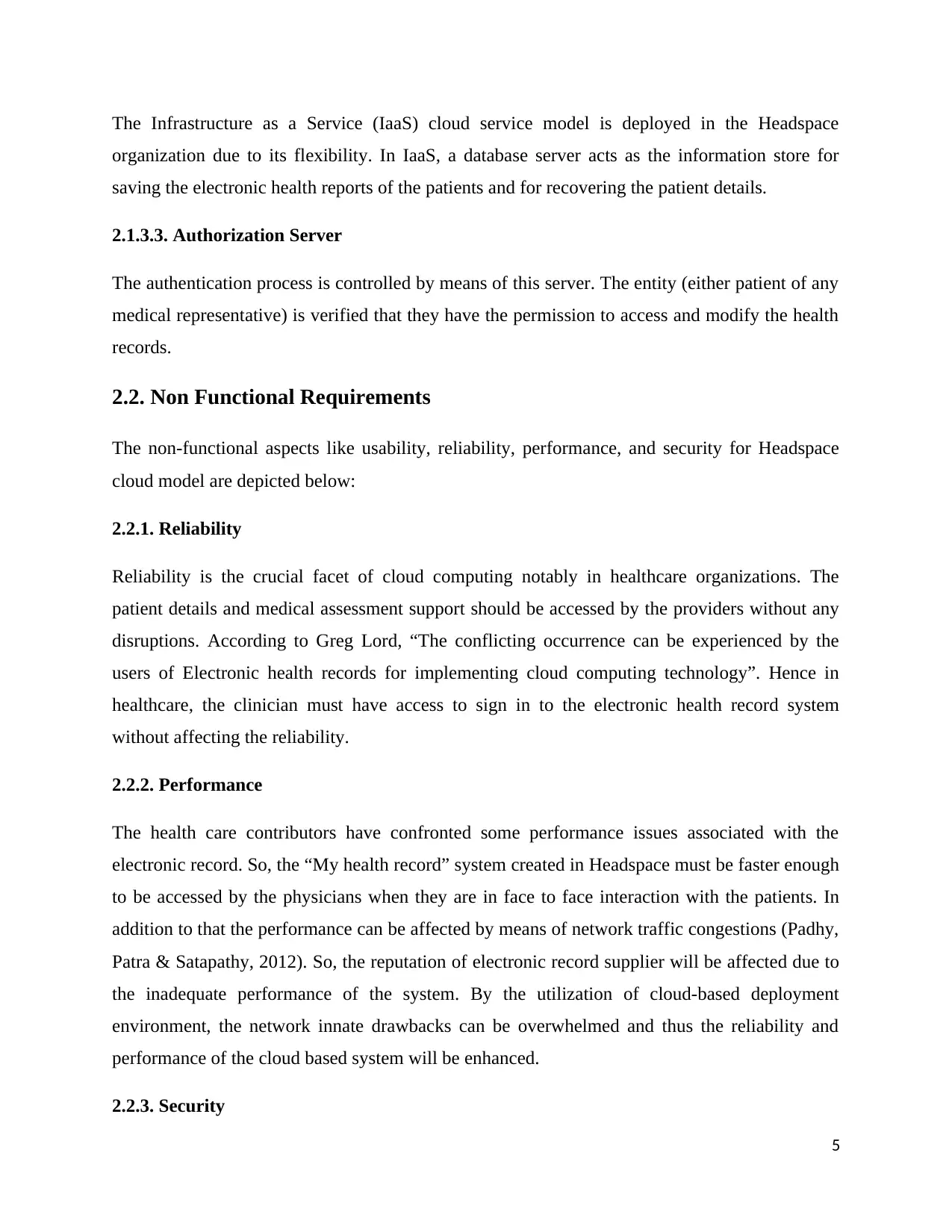
The Infrastructure as a Service (IaaS) cloud service model is deployed in the Headspace
organization due to its flexibility. In IaaS, a database server acts as the information store for
saving the electronic health reports of the patients and for recovering the patient details.
2.1.3.3. Authorization Server
The authentication process is controlled by means of this server. The entity (either patient of any
medical representative) is verified that they have the permission to access and modify the health
records.
2.2. Non Functional Requirements
The non-functional aspects like usability, reliability, performance, and security for Headspace
cloud model are depicted below:
2.2.1. Reliability
Reliability is the crucial facet of cloud computing notably in healthcare organizations. The
patient details and medical assessment support should be accessed by the providers without any
disruptions. According to Greg Lord, “The conflicting occurrence can be experienced by the
users of Electronic health records for implementing cloud computing technology”. Hence in
healthcare, the clinician must have access to sign in to the electronic health record system
without affecting the reliability.
2.2.2. Performance
The health care contributors have confronted some performance issues associated with the
electronic record. So, the “My health record” system created in Headspace must be faster enough
to be accessed by the physicians when they are in face to face interaction with the patients. In
addition to that the performance can be affected by means of network traffic congestions (Padhy,
Patra & Satapathy, 2012). So, the reputation of electronic record supplier will be affected due to
the inadequate performance of the system. By the utilization of cloud-based deployment
environment, the network innate drawbacks can be overwhelmed and thus the reliability and
performance of the cloud based system will be enhanced.
2.2.3. Security
5
organization due to its flexibility. In IaaS, a database server acts as the information store for
saving the electronic health reports of the patients and for recovering the patient details.
2.1.3.3. Authorization Server
The authentication process is controlled by means of this server. The entity (either patient of any
medical representative) is verified that they have the permission to access and modify the health
records.
2.2. Non Functional Requirements
The non-functional aspects like usability, reliability, performance, and security for Headspace
cloud model are depicted below:
2.2.1. Reliability
Reliability is the crucial facet of cloud computing notably in healthcare organizations. The
patient details and medical assessment support should be accessed by the providers without any
disruptions. According to Greg Lord, “The conflicting occurrence can be experienced by the
users of Electronic health records for implementing cloud computing technology”. Hence in
healthcare, the clinician must have access to sign in to the electronic health record system
without affecting the reliability.
2.2.2. Performance
The health care contributors have confronted some performance issues associated with the
electronic record. So, the “My health record” system created in Headspace must be faster enough
to be accessed by the physicians when they are in face to face interaction with the patients. In
addition to that the performance can be affected by means of network traffic congestions (Padhy,
Patra & Satapathy, 2012). So, the reputation of electronic record supplier will be affected due to
the inadequate performance of the system. By the utilization of cloud-based deployment
environment, the network innate drawbacks can be overwhelmed and thus the reliability and
performance of the cloud based system will be enhanced.
2.2.3. Security
5
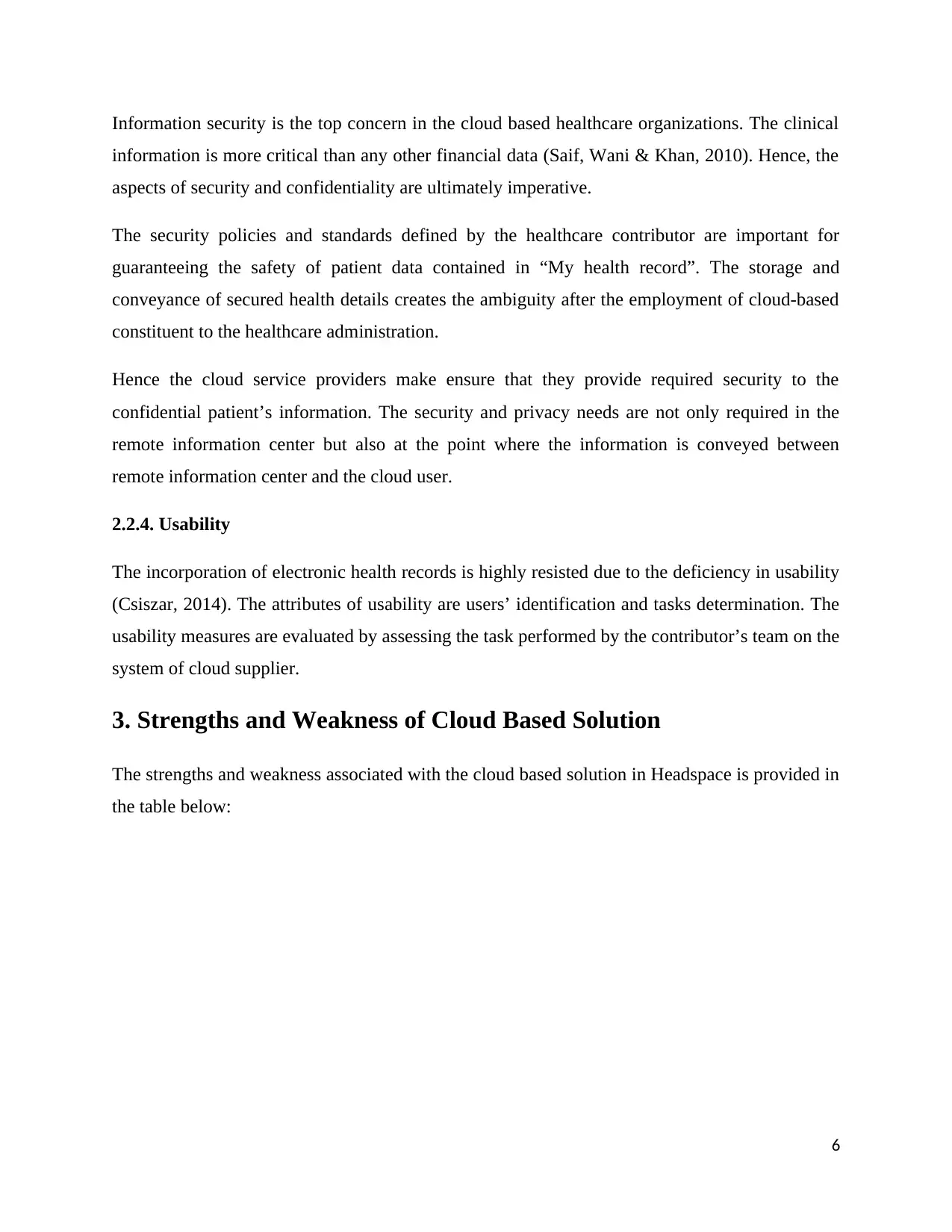
Information security is the top concern in the cloud based healthcare organizations. The clinical
information is more critical than any other financial data (Saif, Wani & Khan, 2010). Hence, the
aspects of security and confidentiality are ultimately imperative.
The security policies and standards defined by the healthcare contributor are important for
guaranteeing the safety of patient data contained in “My health record”. The storage and
conveyance of secured health details creates the ambiguity after the employment of cloud-based
constituent to the healthcare administration.
Hence the cloud service providers make ensure that they provide required security to the
confidential patient’s information. The security and privacy needs are not only required in the
remote information center but also at the point where the information is conveyed between
remote information center and the cloud user.
2.2.4. Usability
The incorporation of electronic health records is highly resisted due to the deficiency in usability
(Csiszar, 2014). The attributes of usability are users’ identification and tasks determination. The
usability measures are evaluated by assessing the task performed by the contributor’s team on the
system of cloud supplier.
3. Strengths and Weakness of Cloud Based Solution
The strengths and weakness associated with the cloud based solution in Headspace is provided in
the table below:
6
information is more critical than any other financial data (Saif, Wani & Khan, 2010). Hence, the
aspects of security and confidentiality are ultimately imperative.
The security policies and standards defined by the healthcare contributor are important for
guaranteeing the safety of patient data contained in “My health record”. The storage and
conveyance of secured health details creates the ambiguity after the employment of cloud-based
constituent to the healthcare administration.
Hence the cloud service providers make ensure that they provide required security to the
confidential patient’s information. The security and privacy needs are not only required in the
remote information center but also at the point where the information is conveyed between
remote information center and the cloud user.
2.2.4. Usability
The incorporation of electronic health records is highly resisted due to the deficiency in usability
(Csiszar, 2014). The attributes of usability are users’ identification and tasks determination. The
usability measures are evaluated by assessing the task performed by the contributor’s team on the
system of cloud supplier.
3. Strengths and Weakness of Cloud Based Solution
The strengths and weakness associated with the cloud based solution in Headspace is provided in
the table below:
6

Strengths Weaknesses
1. The software can be accessed anywhere by
using the gadgets connected with the network.
2. The necessity of utilizing single motionless
computer by the user is avoided.
3. The information can be commuted to other
cloud systems.
4. The software with similar versions is
provided to all the users.
5. Performing upgrades to the earlier versions
are simplified.
6. The management of the software is abridged
and not complicated.
7. The security of the data in electronic health
record is enhanced.
8. The technological assistance is provided by
the system itself.
9. The additional investment for managing the
database is not necessary.
1. The source of data is not known since the
control of data, accessibility, safety, and
management are handed over to a third-party
cloud contributor.
2. Information accessibility, disaster recovery,
quicker response times, and failure restrictions
are difficult to achieve.
3. The service providers possess more
administration capacities when compared to
the end users.
4. The revelation of information without any
authorization leads to severe impacts in the
organizations.
5. When an error or complicated system failure
is encountered, it is difficult to recover and
restore the data. In addition to that, difficulties
arise in notifying the exaggerated users.
6. The data recovery costs are higher when
compared to in-house premises.
7. Pricing firmness and availability is crucial.
8. The entire data in the organization will be
affected if there are any problems with the data
or software.
Hence in order to alleviate the weaknesses, a contract should be signed between the organization
and the cloud service contributors (Hitachi, 2012). Since the cloud suppliers have more control
7
1. The software can be accessed anywhere by
using the gadgets connected with the network.
2. The necessity of utilizing single motionless
computer by the user is avoided.
3. The information can be commuted to other
cloud systems.
4. The software with similar versions is
provided to all the users.
5. Performing upgrades to the earlier versions
are simplified.
6. The management of the software is abridged
and not complicated.
7. The security of the data in electronic health
record is enhanced.
8. The technological assistance is provided by
the system itself.
9. The additional investment for managing the
database is not necessary.
1. The source of data is not known since the
control of data, accessibility, safety, and
management are handed over to a third-party
cloud contributor.
2. Information accessibility, disaster recovery,
quicker response times, and failure restrictions
are difficult to achieve.
3. The service providers possess more
administration capacities when compared to
the end users.
4. The revelation of information without any
authorization leads to severe impacts in the
organizations.
5. When an error or complicated system failure
is encountered, it is difficult to recover and
restore the data. In addition to that, difficulties
arise in notifying the exaggerated users.
6. The data recovery costs are higher when
compared to in-house premises.
7. Pricing firmness and availability is crucial.
8. The entire data in the organization will be
affected if there are any problems with the data
or software.
Hence in order to alleviate the weaknesses, a contract should be signed between the organization
and the cloud service contributors (Hitachi, 2012). Since the cloud suppliers have more control
7
Paraphrase This Document
Need a fresh take? Get an instant paraphrase of this document with our AI Paraphraser
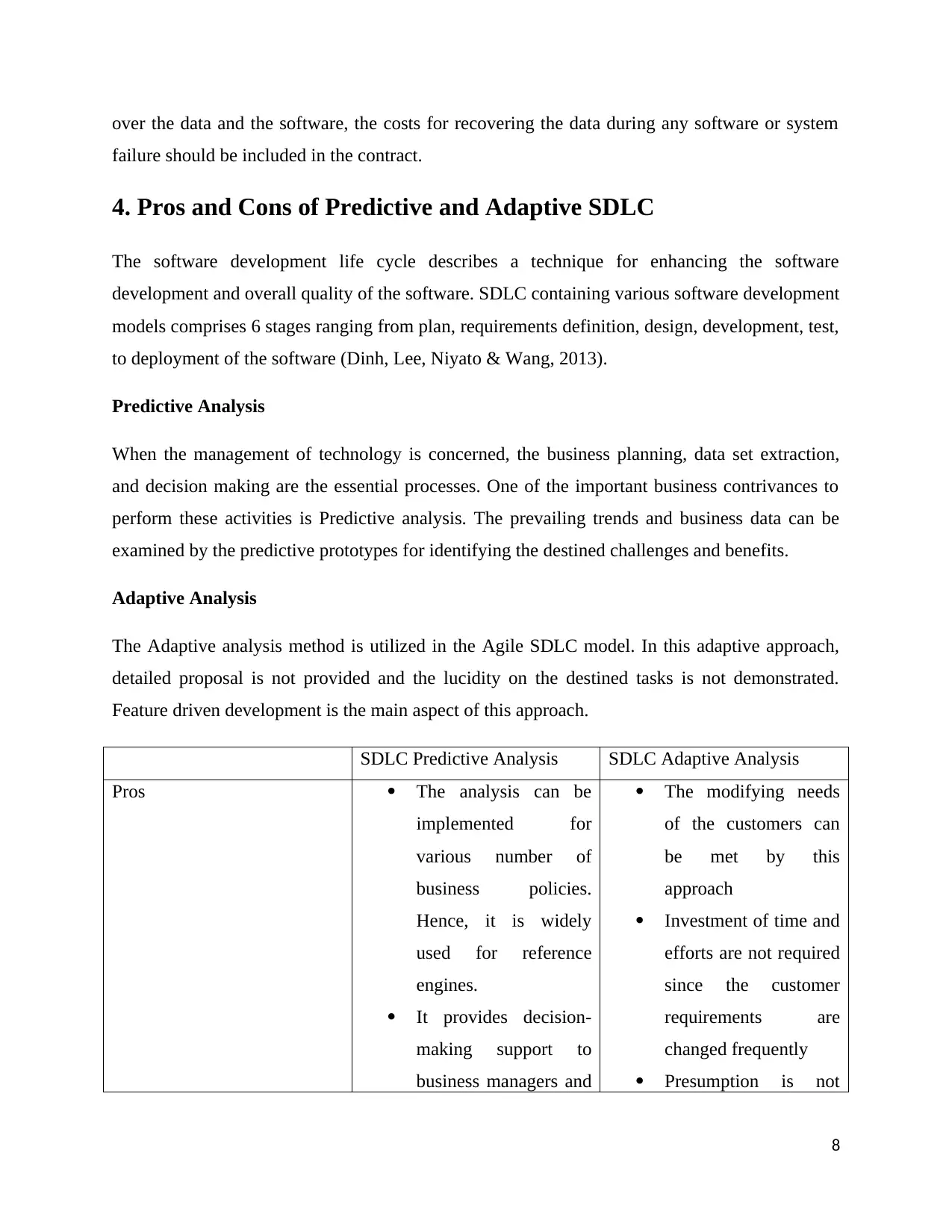
over the data and the software, the costs for recovering the data during any software or system
failure should be included in the contract.
4. Pros and Cons of Predictive and Adaptive SDLC
The software development life cycle describes a technique for enhancing the software
development and overall quality of the software. SDLC containing various software development
models comprises 6 stages ranging from plan, requirements definition, design, development, test,
to deployment of the software (Dinh, Lee, Niyato & Wang, 2013).
Predictive Analysis
When the management of technology is concerned, the business planning, data set extraction,
and decision making are the essential processes. One of the important business contrivances to
perform these activities is Predictive analysis. The prevailing trends and business data can be
examined by the predictive prototypes for identifying the destined challenges and benefits.
Adaptive Analysis
The Adaptive analysis method is utilized in the Agile SDLC model. In this adaptive approach,
detailed proposal is not provided and the lucidity on the destined tasks is not demonstrated.
Feature driven development is the main aspect of this approach.
SDLC Predictive Analysis SDLC Adaptive Analysis
Pros The analysis can be
implemented for
various number of
business policies.
Hence, it is widely
used for reference
engines.
It provides decision-
making support to
business managers and
The modifying needs
of the customers can
be met by this
approach
Investment of time and
efforts are not required
since the customer
requirements are
changed frequently
Presumption is not
8
failure should be included in the contract.
4. Pros and Cons of Predictive and Adaptive SDLC
The software development life cycle describes a technique for enhancing the software
development and overall quality of the software. SDLC containing various software development
models comprises 6 stages ranging from plan, requirements definition, design, development, test,
to deployment of the software (Dinh, Lee, Niyato & Wang, 2013).
Predictive Analysis
When the management of technology is concerned, the business planning, data set extraction,
and decision making are the essential processes. One of the important business contrivances to
perform these activities is Predictive analysis. The prevailing trends and business data can be
examined by the predictive prototypes for identifying the destined challenges and benefits.
Adaptive Analysis
The Adaptive analysis method is utilized in the Agile SDLC model. In this adaptive approach,
detailed proposal is not provided and the lucidity on the destined tasks is not demonstrated.
Feature driven development is the main aspect of this approach.
SDLC Predictive Analysis SDLC Adaptive Analysis
Pros The analysis can be
implemented for
various number of
business policies.
Hence, it is widely
used for reference
engines.
It provides decision-
making support to
business managers and
The modifying needs
of the customers can
be met by this
approach
Investment of time and
efforts are not required
since the customer
requirements are
changed frequently
Presumption is not
8
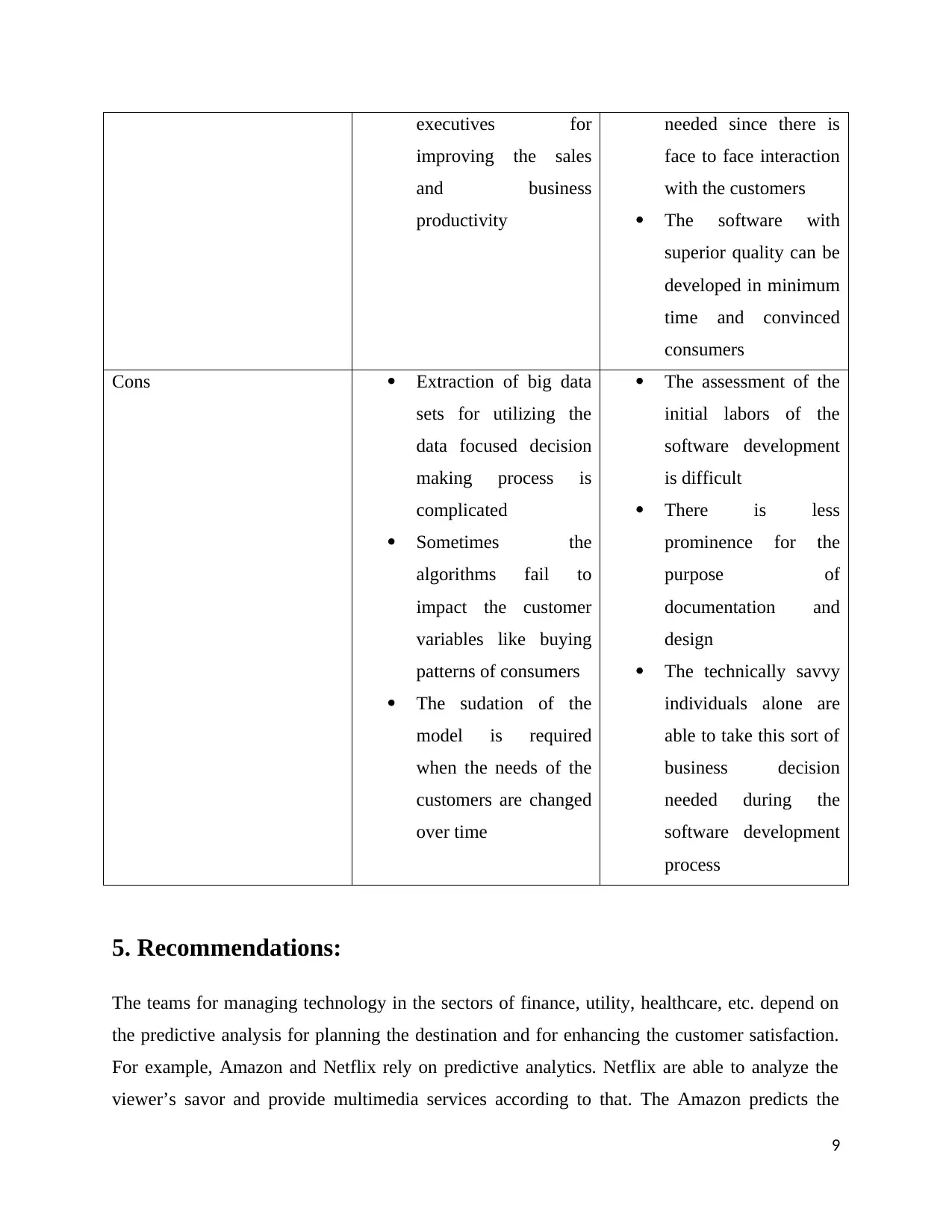
executives for
improving the sales
and business
productivity
needed since there is
face to face interaction
with the customers
The software with
superior quality can be
developed in minimum
time and convinced
consumers
Cons Extraction of big data
sets for utilizing the
data focused decision
making process is
complicated
Sometimes the
algorithms fail to
impact the customer
variables like buying
patterns of consumers
The sudation of the
model is required
when the needs of the
customers are changed
over time
The assessment of the
initial labors of the
software development
is difficult
There is less
prominence for the
purpose of
documentation and
design
The technically savvy
individuals alone are
able to take this sort of
business decision
needed during the
software development
process
5. Recommendations:
The teams for managing technology in the sectors of finance, utility, healthcare, etc. depend on
the predictive analysis for planning the destination and for enhancing the customer satisfaction.
For example, Amazon and Netflix rely on predictive analytics. Netflix are able to analyze the
viewer’s savor and provide multimedia services according to that. The Amazon predicts the
9
improving the sales
and business
productivity
needed since there is
face to face interaction
with the customers
The software with
superior quality can be
developed in minimum
time and convinced
consumers
Cons Extraction of big data
sets for utilizing the
data focused decision
making process is
complicated
Sometimes the
algorithms fail to
impact the customer
variables like buying
patterns of consumers
The sudation of the
model is required
when the needs of the
customers are changed
over time
The assessment of the
initial labors of the
software development
is difficult
There is less
prominence for the
purpose of
documentation and
design
The technically savvy
individuals alone are
able to take this sort of
business decision
needed during the
software development
process
5. Recommendations:
The teams for managing technology in the sectors of finance, utility, healthcare, etc. depend on
the predictive analysis for planning the destination and for enhancing the customer satisfaction.
For example, Amazon and Netflix rely on predictive analytics. Netflix are able to analyze the
viewer’s savor and provide multimedia services according to that. The Amazon predicts the
9

product choice of the customers and transmits that packages to the destined region of the
customers before they purchases the products.
So, based on the advantages provided by predictive analytics, the Headspace organization can
utilize it for ensuring data safety and for improving the patient’s satisfaction.
6. Conclusion:
In this report, the functional and non-functional requirements for developing “My Health
Record” system are discussed. The management of the patient’s health records can be
accomplished by adopting the cloud technology. In addition to that, the reduction of management
drawbacks can be reduced thereby lowering the healthcare costs. Moreover, the electronic health
reports, pharmacy reports, physician’s notes, and digital medical representation can be acquired
in real time. Headspace customizes the healthcare industry by executing the analytics on the
constituted cloud data.
7. Reference:
Ahuja, P., Sindhu, M. & Jesus, Z. (2012).A Survey of the State of Cloud Computing in
Healthcare. Network and Communication Technologies, 1(2), 12-19.
Cristina, C. (2010). Electronic Health Record Adoption: Perceived Barriers and Facilitators-A
Literature Review. Centre for Military and Veterans’ Health, 1-53.
Dinh, H. T., Lee, C., Niyato, D. & Wang, P. (2013).A survey of mobile cloud computing:
architecture, applications, and approaches. Wireless Communications and mobile
computing, 13(8), 1580-1611.
Hitachi (2012). How to Improve Healthcare with Cloud Computing, Hitachi Data Systems, 1-20.
Csiszar, J. (2014, February 8). Paper-Based Medical Records vs. Electronic Medical Records.
Retrieved from http://www.voices.yahoo.com/paper-based-medical-records-vs-
electronic-medical- 8591569.html
Padhy, R., Patra, M. &Satapathy, S. (2012). Design and Implementation of a Cloud based Rural
Healthcare Information System Model. UNIASCIT, 2 (1), 149-157.
10
customers before they purchases the products.
So, based on the advantages provided by predictive analytics, the Headspace organization can
utilize it for ensuring data safety and for improving the patient’s satisfaction.
6. Conclusion:
In this report, the functional and non-functional requirements for developing “My Health
Record” system are discussed. The management of the patient’s health records can be
accomplished by adopting the cloud technology. In addition to that, the reduction of management
drawbacks can be reduced thereby lowering the healthcare costs. Moreover, the electronic health
reports, pharmacy reports, physician’s notes, and digital medical representation can be acquired
in real time. Headspace customizes the healthcare industry by executing the analytics on the
constituted cloud data.
7. Reference:
Ahuja, P., Sindhu, M. & Jesus, Z. (2012).A Survey of the State of Cloud Computing in
Healthcare. Network and Communication Technologies, 1(2), 12-19.
Cristina, C. (2010). Electronic Health Record Adoption: Perceived Barriers and Facilitators-A
Literature Review. Centre for Military and Veterans’ Health, 1-53.
Dinh, H. T., Lee, C., Niyato, D. & Wang, P. (2013).A survey of mobile cloud computing:
architecture, applications, and approaches. Wireless Communications and mobile
computing, 13(8), 1580-1611.
Hitachi (2012). How to Improve Healthcare with Cloud Computing, Hitachi Data Systems, 1-20.
Csiszar, J. (2014, February 8). Paper-Based Medical Records vs. Electronic Medical Records.
Retrieved from http://www.voices.yahoo.com/paper-based-medical-records-vs-
electronic-medical- 8591569.html
Padhy, R., Patra, M. &Satapathy, S. (2012). Design and Implementation of a Cloud based Rural
Healthcare Information System Model. UNIASCIT, 2 (1), 149-157.
10
Secure Best Marks with AI Grader
Need help grading? Try our AI Grader for instant feedback on your assignments.
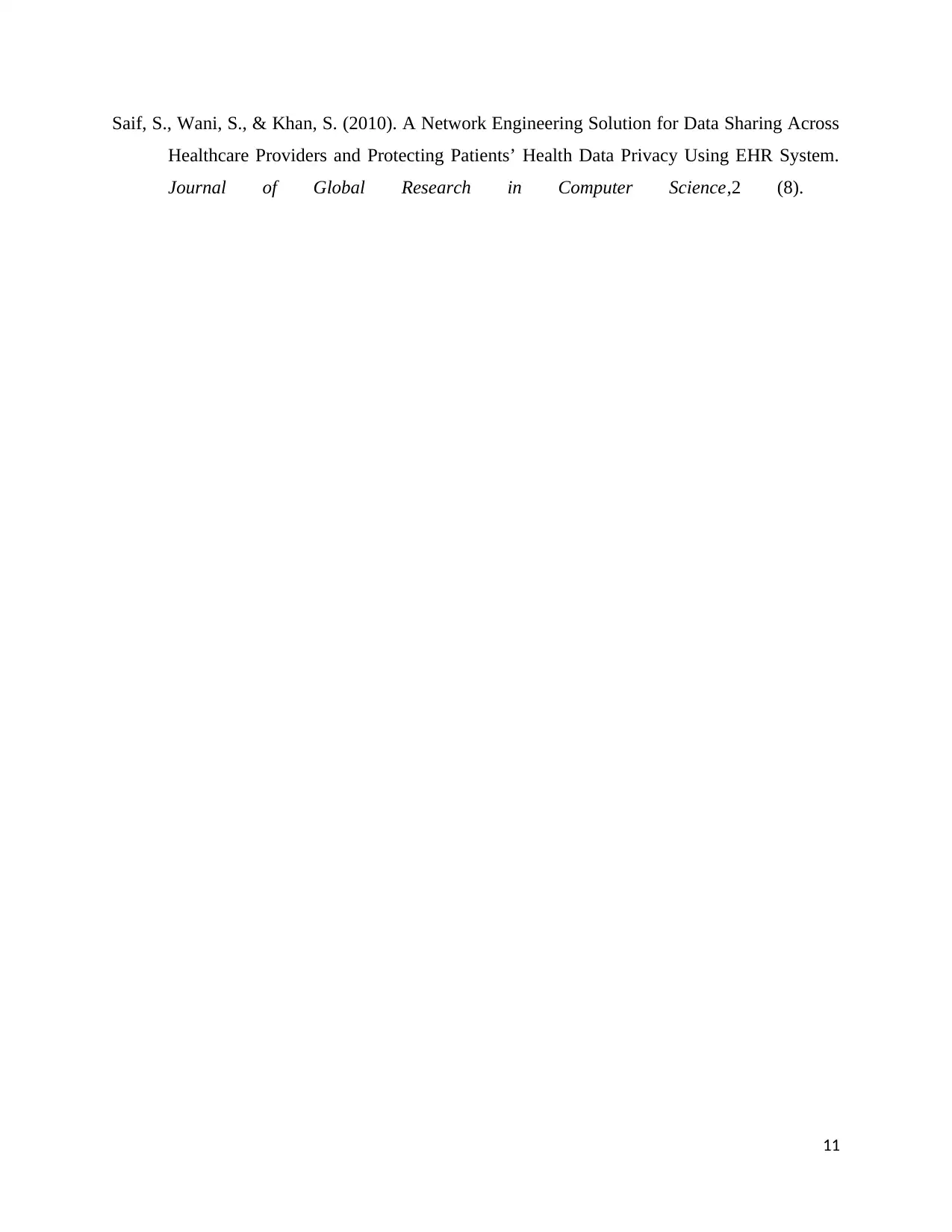
Saif, S., Wani, S., & Khan, S. (2010). A Network Engineering Solution for Data Sharing Across
Healthcare Providers and Protecting Patients’ Health Data Privacy Using EHR System.
Journal of Global Research in Computer Science,2 (8).
11
Healthcare Providers and Protecting Patients’ Health Data Privacy Using EHR System.
Journal of Global Research in Computer Science,2 (8).
11
1 out of 11
Related Documents
Your All-in-One AI-Powered Toolkit for Academic Success.
+13062052269
info@desklib.com
Available 24*7 on WhatsApp / Email
![[object Object]](/_next/static/media/star-bottom.7253800d.svg)
Unlock your academic potential
© 2024 | Zucol Services PVT LTD | All rights reserved.





